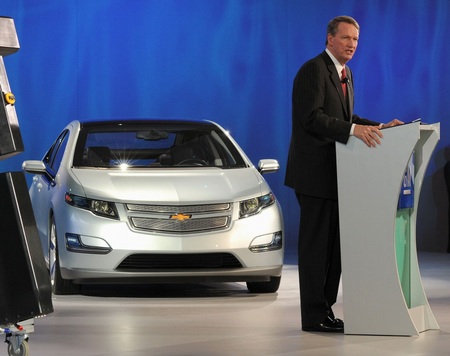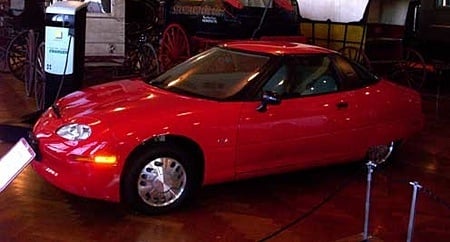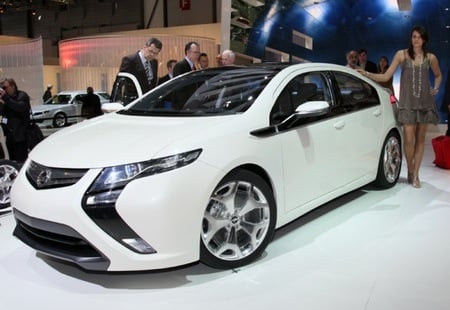Original URL: https://www.theregister.com/2009/04/06/wagoner_out/
Wagoner: EVillain or EVictor?
Will former General Motors CEO be remembered for Volt or EV1?
Posted in Science, 6th April 2009 14:09 GMT
'Leccy Tech So it's goodbye to Rick Wagoner, General Motor's youngest ever CEO and a man whose legacy will have people arguing long into the evenings.
Following what must have been an interesting chat with President Obama – or more likely one of the heavy hitters from the President's Auto Task Force – it was apparently agreed that whatever GM's future, Wagoner didn't feature in it. So he makes way for GM president and COO Fritz Henderson to assume the role of CEO.
Leaving aside the simple fact that GM is currently on its knees and dependent on either massive handouts from the US taxpayer and/or a short, surgical bankruptcy for its survival, Wagoner will be remembered among the electric vehicle community as the man who killed the EV1 and gave birth to the Volt. And that's quite a dichotomy.

Wagoner and Volt: too late?
Despite all the conspiracy theories about the death of the EV1 – not least those given rather too free a reign in Chris Paine's film Who Killed The Electric Car - it is unfair to see Wagoner as some sort of evil genius rubbing his hands with glee at the demise of the project.
The EV1 was a hugely expensive project that was only launched to comply with the State of California's zero emissions mandate. Once that was overturned the project was probably doomed. With less than 1200 cars on the road by the end of 1999, the EV1 project never made commercial sense and it's questionable if GM ever really saw it as much more than a wide-scale engineering evaluation project and the cost of doing business in the state.
GM's problem with the EV1 wasn't that it cancelled it, but rather how it cancelled it. As an exercise in hubris and stupidity it takes some beating, even in the annals of US corporate history. The refusal to discuss buy-outs with lease owners; the haste with which it crushed the surviving cars; the refusal to simply explain the reasoning behind its decisions and actions. The whole situation was so poorly handled it's hardly surprising that people saw the dark shadow of a vast conspiracy between Big Auto and Big Oil.
Last year, Wagoner twice went on the record to state that killing the EV1 was the biggest mistake he ever made – presumably right up there with using the GM corporate jet to visit Washington to ask for Federal aid. Whether or not he actually meant it, or had an eye on kissing up to the environmental lobby, is, of course, another matter.
That's not to say the EV1 wasn't a lost opportunity - it was. As Larry Burns, head of GM's R&D division said in a Newsweek interview in 2007: “If we could turn back the hands of time we could have had the Chevy Volt 10 years earlier."

Axed: GM's EV1
Wagoner's status as a hate figure for the environmentalists was further reinforced by the Hummer project, which many would hold up as symbolic of the basic problem with GM: it has spent the last decade building simple, cheap-to-manufacture trucks and SUVs rather than innovating. In the process, it surrendered the market for well made, technically advanced, modern family cars to the likes of Honda and Toyota.
When oil prices rose and fuel efficiency became an issue with car buyers, GM was stuck with a not undeserved reputation for making crude vehicles with poor economy.
Since then GM has been piling all its eggs into the Volt basket with almost indecent haste, making it currently the only model GM has spared from cuts in its development budget.
But the Volt was too little and too late to save Wagoner. The Auto Task Force's report to the President contained a damming statement:
"GM is at least one generation behind Toyota on advanced, 'green' power train development. In an attempt to leapfrog Toyota, GM has devoted significant resources to the Chevy Volt. While the Volt holds promise, it is currently projected to be much more expensive than its gasoline-fuelled peers and will likely need substantial reductions in manufacturing cost in order to become commercially viable.”
It's hard to argue with that conclusion. We think the Volt is a great idea and have our fingers crossed that come 2012, we'll be able to take a right-hand drive Opel Ampera for a spin here in the UK. But a car to save a company the size of General Motor's it is not.
That's the problem with scrabbling to play catch up and touting a model that you have admitted won't make a dime in profit as the reason for the tax payer to dig deep and keep you in business. And it's not the only the problem from the Oval Office's perspective.

Ampera: Europe's Volt
In 2008, GM sold 177,000 Chevrolet Malibus in the US. Now the Malibu is a pretty good car, albeit one based on an ageing platform developed by Opel in Europe that is also used as the basis for both the Saab 9-3 and Opel Vectra. But in the same market and during the same time period, Honda sold 372,000 Accords while Toyota shifted over 436,000 Camrys.
That's GM's real problem - and Wagoner's real legacy – a major lack of competitiveness in the mass market. Until the company gets that sorted, betting the family farm on the Volt looks less like clever long-term planning and more like green-washed desperation. ®